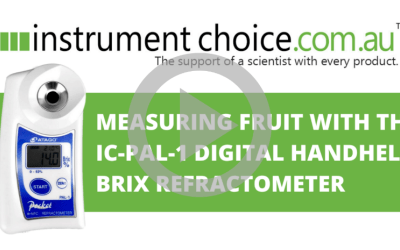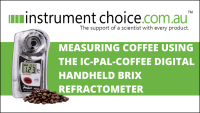How to Measure Brix in Fruit Using Atago’s IC-PAL-1 Handheld Pocket Brix Refractometer

Brix is the measurement of the sugar content within a liquid solution. One degree Brix is equivalent to 1 gram of sucrose in 100 grams of the measured solution. Brix results display in degrees Brix (°Bx) or express as a percentage.
Brix refractometers are often used to measure sucrose levels within a wide range of food and beverage, including fruits, vegetables, condiments, juices, soft drinks, wine and beer. Brix Refractometers provide professionals a wealth of information at the touch of a button, giving insight to a product's taste, quality, and nutritional density.
The IC-PAL-1 handheld pocket refractometer by Atago makes it easy to measure Brix. This video article shows how to take a Brix measurement using the Atago IC-PAL-1 digital handheld Brix refractometer.
Figure 1 Watch the Instrument Choice Scientists demonstrate how to measure fruit using the Atago IC-PAL-1 Digital Handheld Refractometer here.
How to measure fruit on the IC-PAL-1 Handheld Pocket Brix Refractometer by Atago
- At the beginning of each day, before taking a measurement or after changing the Atago’s batteries, you must perform a zero-set calibration. Here’s how; take approximately 0.3mL of water and place it on the device’s prism, then press the ‘START’ button to confirm that the water sample measures at 0.0.
- If the sample is not reading at 0.0 press the ‘ZERO’ button, otherwise wipe away the water and proceed to measurement.
- Then squeeze out the juice from the sample (approx. 0.3mL) onto the prism.
- Press the start button.
- Within three seconds, the Brix percentage of the fruit sample will display on the screen.
- Final step: Thoroughly wipe away the sample, ensuring that there is no residue remaining.
NOTE: Once testing has finished, it’s good practice to wash down the refractometer prism with warm water, and a mild detergent then make dry the Atago meter using tissues.
CONCLUSION
Taking Brix measurements using the Atago handheld pocket refractometers is a simple task that will allow you to obtain vital data about the sugar level of fruit within three seconds.
ADDITIONAL LINKS
- Want more information on Brix Refractometers and How they work? Learn more here.
- Watch a video of an Instrument Choice Scientist Unboxing the IC-PAL-1 here.
- Want the data history from your Atago pocket meter sent straight to your phone? See a video on How to use the Data Transmission Function on Atago Pocket Refractometers here.
Also interesting
Coffee is arguably the world’s most popular addictive substance of choice. Consumers are becoming increasingly sophisticated, and as a result, many baristas are using scientific instruments to ensure the perfect brew!
It turns out that the Brix percentage indicates the typical strength of a coffee. This measurement provides a well-trained barista insights into the solubility of a roast, how to setup up their equipment, even how to achieve the perfect roast of coffee beans.
Are you interested in taking coffee brewing to the next level? The Atago IC-PAL-Coffee is a device Instrument Choice recommends to baristas, principally because the instrument is capable of determining a subtle difference in a coffee brew’s concentration to a high resolution of 0.01%! What's more, stable readings are possible, even at high temperatures, which is a result of the Atago’s continuous measurement feature.

Red cabbage can be a taste divider, but whether you love it or hate it, did you know it can also be a useful pH indicating tool?
In this experiment, we use red cabbage to estimate the pH of several everyday household products then test our results against a pH meter to find out just how accurate red cabbage can be as a pH indicator!

